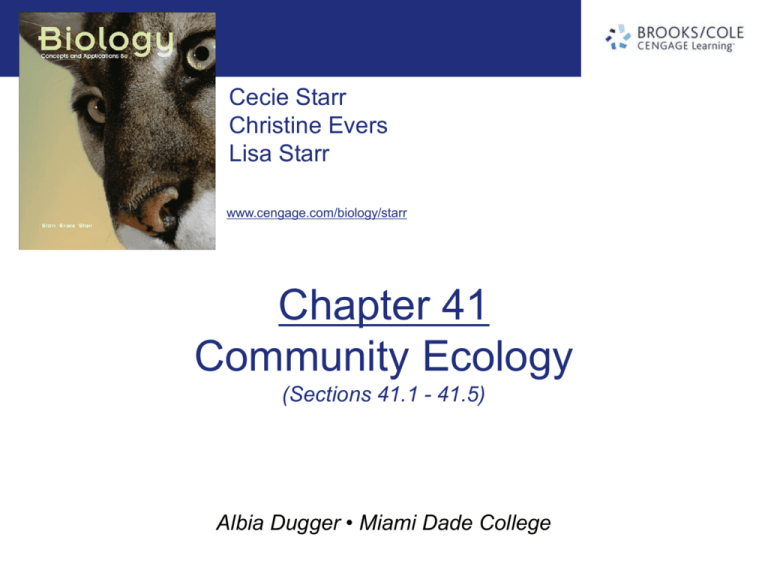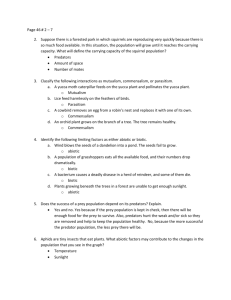chapter41_Sections 1
advertisement

Cecie Starr Christine Evers Lisa Starr www.cengage.com/biology/starr Chapter 41 Community Ecology (Sections 41.1 - 41.5) Albia Dugger • Miami Dade College 41.1 Fighting Foreign Fire Ants • Red imported fire ants, Solenopsis invicta, have a venomous sting, disrupt native wildlife communities, and are not controlled by pesticides • Biological control involves phorid flies, specialized parasites (parasitoids) that kill their host by laying an egg in the ant’s tissues – the larvae eats its way through the fire ant and undergoes metamorphosis in its head • community • All species that live in a particular region Phorid Fly and Fire Ant • Phorid flies insert a fertilized egg into an ant’s thorax • Parasitized ant that lost its head after a developing fly larva moved into it 41.2 Community Structure • The type of place where a species normally lives is its habitat, and all species living in a habitat constitute a community • Communities often are nested one inside another • habitat • Type of environment in which a species typically lives Species Diversity • Communities differ in their species diversity • Species diversity has two components: • Species richness (number of species) • Species evenness (relative abundance of each species) • Community structure is dynamic • Species richness and evenness change over time Factors Affecting Community Structure • Community structure can change: • As the community forms and ages • As a result of natural or human-induced disturbances • With changes in physical factors such as climate and resource availability • Due to various types of species interactions Species Interactions • Species interactions can be mutually beneficial, mutually harmful, or benefit one species while harming the other • Example: Commensal ferns attached to the trunk of a tree; the fern benefits from the light, and the tree is unaffected • commensalism • Species interaction that benefits one species and neither helps nor harms the other Commensalism • A tree with a commensal fern • The fern benefits by growing on the tree, which is unaffected by the presence of the fern Types of Two-Species Interactions • • • • Type of Interaction Species 1 Species 2 Commensalism Mutualism Interspecific competition Predation, herbivory parasitism, parasitoidism Helpful Helpful Harmful None Helpful Harmful Helpful Harmful Symbiosis • Symbiosis (“living together”) refers to a relationship in which two species have a prolonged close association • Two species that interact closely for generations can coevolve – an evolutionary process in which each species acts as a selective agent on the other • symbiosis • One species lives in or on another in a commensal, mutualistic, or parasitic relationship Key Concepts • Community Characteristics • A community consists of all species in a habitat • A habitat’s history, its biological and physical characteristics, and interactions among species in the habitat affect the number of species in the community and their relative abundance 41.3 Mutualism • In a mutualistic interaction, two species benefit by taking advantage of one another • Example: Pollinators eat nectar and pollen, and plants receive pollen from other plants of the same species • mutualism • Species interaction that benefits both species Mutualism and Coevolution • In some mutualisms, neither species can complete its life cycle without the other • Example: Yucca plants and the moths that pollinate them • The moth matures when yucca flowers bloom • Mouthparts of the female moth are specialized to collect yucca pollen • Female flies to another flower, pierces its ovary, and lays eggs inside – fertilizing the yucca as she leaves • Moth eggs develop into larvae in the ovary of the yucca Yucca Plant and Yucca Moth Mutualism and Defense • For some mutualists, the main benefit is defense • Example: Sea anemone and anemone fish • An anemone fish has a mucus layer that shields it from stinging cells (nematocysts) of a sea anemone • Tentacles of the anemone protect the fish from predators • The anemone fish chases away the few fishes that are able to eat sea anemone tentacles Sea Anemone and Anemone Fish Mutualistic Microorganisms • Mutualistic microorganisms help plants obtain nutrients: • Nitrogen-fixing bacteria on roots of legumes (peas) provide the plant with extra nitrogen • Mycorrhizal fungi living in or on plant roots enhance a plant’s mineral uptake • Other fungi interact with photosynthetic algae or bacteria in lichens 41.4 Competitive Interactions • Resources are limited and individuals of different species often compete for access to them (interspecific competition) • Competition adversely affects both species • interspecific competition • Competition between two species Ecological Niche • Each species has an ecological niche defined by physical and biological factors; the more similar the niches of two species are, the more intensely they will compete • An animal’s niches include the temperature range it can tolerate, species it eats, and places it can breed • A flowering plant’s niche would include its soil, water, light, and pollinator requirements • ecological niche • All of a species’ requirements and roles in an ecosystem Two Types of Interspecific Competition • Exploitative competition: • Two species reduce the amount of resources available to the other by using that resource • Example: Deer and blue jays compete for acorns • Interference competition: • One species actively prevents another from accessing some resource • Example: One species of scavenger will often chase another away from a carcass Interference Competition Interference Competition A Golden eagle and a red fox face off over a moose carcass. B In a dramatic demonstration of interference competition, the eagle attacks the fox with its talons. After this attack, the fox retreated, leaving the eagle to exploit the carcass. Stepped Art Fig. 41.5, p. 694 Effects of Competition • Species compete most intensely when a shared resource is the main limiting factor for both • Whenever two species require the same limited resource to survive or reproduce, the better competitor will drive the less competitive species to extinction in that habitat • competitive exclusion • Process whereby two species compete for a limiting resource, and one drives the other to local extinction Experiment: Competitive Exclusion • Two Paramecium species compete for the same food (bacteria) • Each species thrives when grown alone • When grown together, P. aurelia drove P. caudatum to extinction Experiment: Competitive Exclusion Experiment: Competitive Exclusion Fig. 41.6.1, p. 695 Experiment: Competitive Exclusion Fig. 41.6.2, p. 695 Experiment: Competitive Exclusion Fig. 41.6.3, p. 695 0 4 8 12 16 20 24 Time (days) 0 P. aurelia alone 4 8 12 16 20 24 Time (days) Relative population density P. caudatum alone Relative population density Relative population density Experiment: Competitive Exclusion 0 Both species together 4 8 12 16 20 24 Time (days) Stepped Art Fig. 41.6, p. 695 ANIMATION: Competitive Exclusion To play movie you must be in Slide Show Mode PC Users: Please wait for content to load, then click to play Mac Users: CLICK HERE Resource Partitioning • Resource partitioning is an evolutionary process by which species become adapted to use a shared limiting resource in a way that minimizes competition • Example: Three plant species growing in the same field • resource partitioning • Species become adapted in different ways to access different portions of a limited resource • Allows species with similar needs to coexist Resource Partitioning • Roots of each species take up water and mineral ions from a different soil depth • Reduces competition among the species and allows them to coexist Character Displacement • Directional selection occurs when species with similar requirements share a habitat and compete for a limiting resource, resulting in character displacement • Example: Beak sizes in Galapagos finches • character displacement • Outcome of competition between two species • Directional selection shifts the range of variation for one or more traits in a direction that lessens competition for a limiting resource ANIMATION: Hairston's Experiment To play movie you must be in Slide Show Mode PC Users: Please wait for content to load, then click to play Mac Users: CLICK HERE ANIMATION: Resource Partitioning To play movie you must be in Slide Show Mode PC Users: Please wait for content to load, then click to play Mac Users: CLICK HERE 41.5 Predation and Herbivory • Predation and herbivory are short-term interactions in which one species obtains nutrients and energy by feeding on another • predation • One species (the predator) captures, kills, and eats another species (the prey) Predator and Prey Abundance • The abundance of prey species in a community affects how many predators it can support • With some predators, such as web-spinning spiders, the proportion of prey killed is constant • Usually, the number of prey killed depends on the time it takes predators to capture, eat, and digest prey Predator and Prey Abundance (cont.) • Predator and prey populations may rise and fall in cycles • Example: Lynx and snowshoe hare populations rise and fall over a ten-year cycle Lynx and Snowshoe Hare Coevolution of Predators and Prey • Predator and prey exert selection pressure on one another • Predators exert selection pressure that favors improved prey defenses • Improved prey defenses in turn exert selection pressure on predators to improve capture skills, and so on Defensive Adaptations • Defensive adaptations of prey include hard or sharp parts that make prey difficult to eat, and chemicals that taste bad or sicken predators • Other adaptations trick or startle an attacking predator • Well-defended prey often have warning coloration that predators learn to avoid, such as the black and yellow stripes of stinging wasps and bees Defensive Adaptations (cont.) • In a type of mimicry, prey masquerade as a species that has a defense that they lack • Example: Some flies that can’t sting resemble stinging bees or wasps • mimicry • A species evolves traits that make it more similar in appearance to another species Wasp and Mimic Predator Adaptations • Predator adaptations include sharp teeth and claws • Predators and prey may be coevolved for speed • Example: cheetah and gazelle • Both predators and prey use camouflage (a form, patterning, color, or behavior that allows them to blend into their surroundings) to avoid detection Camouflage in Prey and Predators Coevolution of Herbivores and Plants • With herbivory, the number and type of plants in a community can influence the number and type of herbivores present • herbivory • An animal feeds on plant parts Herbivores and Plants (cont.) • There are two types of defenses against herbivory: • Some plants have adapted to withstand and recover quickly from herbivory • Other plants have traits such as spines, tough leaves, or toxins that deter herbivory • Plant defenses favor adaptations in herbivores • Example: Koalas have special enzymes to break down toxins in eucalyptus ANIMATION: Predator-Prey Interactions To play movie you must be in Slide Show Mode PC Users: Please wait for content to load, then click to play Mac Users: CLICK HERE









